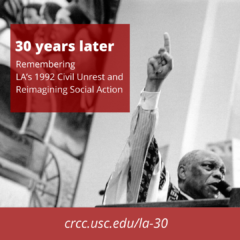In 2012—two decades after the 1992 civil unrest—CRCC published “Forging a New Moral and Political Agenda” to track developments that had been uncovered in “Politics of the Spirit.” The networks and coalitions that formed immediately after the civil unrest had tended to dissolve if they were organized around short-term problems, while organizational relationships forged around long-term goals tended to endure. Cynicism toward the possibility of a national political response to racism and social injustice seemed justified, though reframing these obdurate problems as moral rather than political issues seemed to offer some hope that repentance, reconciliation and restitution could be won by activating the liberationist impulses that had held faith-based coalitions together.
Read “Forging a New Moral and Political Agenda”
The social response to the not-guilty verdict in the Rodney King beating trial and the suspended sentence for Latasha Harlins’ killer was a watershed moment that provided an opportunity for congregations and other religious bodies to establish relationships across racial, ethnic and economic divides:
Since 1992, significant demographic and political events have altered the landscape of Los Angeles, and of the faith community. While faith groups have always participated to varying degrees in the public sphere, over the past two decades they have become expected partners in dealing with social issues. This has resulted in a substantial increase in the number of faith-based nonprofit organizations and a diversity of approaches to the problems they seek to address.
In the immediate aftermath of the civil unrest, faith groups established programs to address the symptoms and the underlying social issues of a fractured city. Many of these efforts lasted less than three years, but they accomplished the goal of quelling tensions and expanding interfaith and interethnic understanding. Other efforts had the organizational capacity to sustain coalitions and bolster community development activity.
Between 1995 and 2010, political developments such as Charitable Choice legislation in 1996, the promotion of faith-based initiatives during the administrations of Presidents Bush and Obama, and the needs of overburdened public agencies, have served to increase the public activities of the faith community. These expanded efforts mirror the pluralism in Los Angeles and its inherent complexities.
Nonetheless, the fact that interfaith action seemed most effective when it was organized around specific issues also carried a degree of liability. The keen focus on relatively narrow concerns that cut across constituencies meant that broadening networks and capacities was more difficult:
The net result of the many programs and faith organizations operating across these five general areas—charity, organizing, advocacy, community development and interfaith dialogue—is that there is now a “new normalcy” attached to the inclusion of faith groups in an array of civic efforts across the city and county. Still, networks across the spectrum of the faith community, regardless of which area of activity they emphasize, are, for the most part, closed organizational systems that rarely interact with other networks. Instead, they tend to focus their efforts on particular issues—neighborhood economic development, easing tension between different constituencies, and narrowly defined policy initiatives—that limit the scope of their work.
CRCC’s researchers concluded that realizing the full potential of faith-based networks and coalitions might entail leveraging the moral authority of faith groups to inspire collective action on bigger problems:
Perhaps the most powerful contribution that the faith community can make is to change the civic discourse of Los Angeles by reframing the region’s challenges as issues that demand moral rather than purely political responses…. For example, recent research suggests that the extreme levels of inequality we are seeing now in the U.S. can undermine social trust and community life, effectively corroding society from the inside out. Social unrest and riots are a predictable consequence of failed expectations and dramatic levels of social inequality….
Moral imagination seems to be in short supply these days…. We are in a moral recession, driven by an economic recession, in which people have lost their vision for what is humanly possible….
The faith community has the opportunity to provide a moral frame for seeking solutions to important issues confronting our city rather than simply striving for pragmatic short-term solutions. The reason the great religions have persevered is that their sacred texts and traditions are strewn with examples of moral failure. But it is in the midst of despair that the prophets find their voice. And this is such a time.
These observations about the corrosive effects of inequality, made a decade before the era of the Trump presidency, are even more apt today. The importance of certain faith groups in Trump’s electoral base prompts some important questions: Are faith groups a source of hope in the cause of social justice today or a reason for despair? Both are increasingly true.
Since 2016, some powerful faith groups have shown us the reactionary side of religion. The religious and political movement anchored by an amoral leader utilizes the moral power of faith leaders to mobilize for regressive cultural goals that in reality contradict the religious message of their faith.
At the same time, the last 30 years show how faith groups can come together to meet the challenges presented by racism and economic inequality, and working together—often across faith lines—to develop communities and opportunity.
Read the full report: “Forging a New Moral and Political Agenda”
As part of “Forging a New Moral and Political Agenda,” CRCC created a database of faith-based organizations active in the five areas: charity, organizing, advocacy, community development and interfaith dialogue. Many, though certainly not all of them, continue to be active in 2022.

